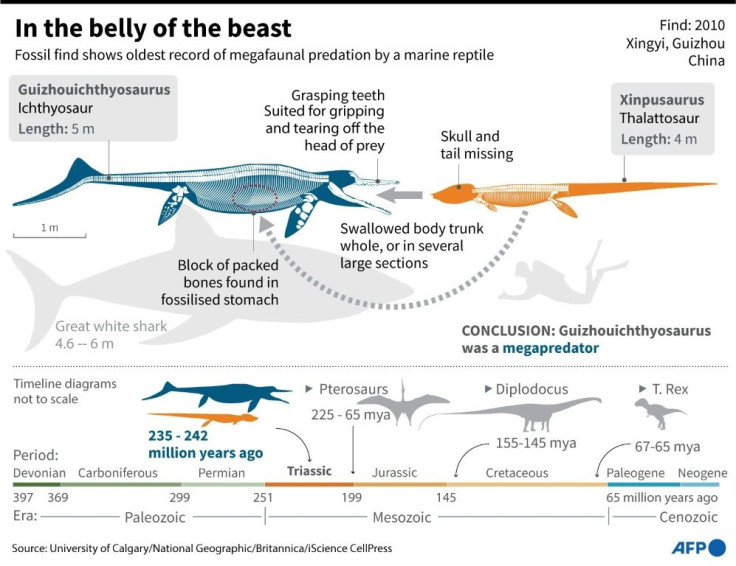Monster Munch: Ancient Marine Reptile Died After Dining On Fellow Titan
More than 230 million years ago, a giant, dolphin-like marine reptile known as an ichthyosaur devoured its final meal -- a creature almost its own size -- then died a short time later.
Inside its belly was the body of a lizard-like aquatic reptile called a thalattosaur, shorn of its head and long tail but undigested.
Paleontologists digging in a quarry in southwestern China were surprised to discover the remains in 2010: it's almost unheard of to find the stomach contents of marine fossils.
A decade on, in a paper published in iScience Thursday, researchers concluded that rather than feeding on much smaller cephalopods like squid, the five-meter (16-foot) long ichthyosaur was probably a megapredator.
What's more, this particular specimen might have died while ingesting its prey, literally biting off more than it could chew.

"The most likely cause of death is the neck breakage, which likely prevented the predator from breathing," co-author Ryosuke Motani, a paleobiologist at the University of California, Davis told AFP.
The ichthyosaur may have sustained injuries while fighting the thalattosaur, he added, or while trying to swallow it -- or both.
But, Motani cautioned: "The interpretation of the death process involves speculation, because nobody was there filming it for us."

The team are a bit more confident that the thalattosaur, which was slightly smaller than its foe at four meters in length, met a violent end, rather than being scavenged after dying of natural causes.
"There are no signs of rotting of the prey -- if it was a rotten carcass, you would not expect to see the fingers still attached to the body," said Motani.
The thalattosaur's disconnected tail was found 20 meters (65 feet) away, leading the team to believe it was ripped off and left behind by the ichthyosaur.
The ichthyosaur's stomach contents didn't show signs of advanced digestion by acid, meaning it likely perished soon after its final meal.
"At first, we just didn't believe it, but after spending several years visiting the dig site and looking at the same specimens, we finally were able to swallow what we were seeing," added Motani.
Because the discovery of stomach contents in marine fossils is so rare, scientists generally rely on tooth and jaw shapes to discern what they may have eaten.
Ancient apex predators are typically thought to have had large, very sharp teeth -- even though some modern predators like crocodiles use blunt teeth to consume large prey using grasping force instead of cutting.
Ichthyosaurs have blunt teeth, but because there was no direct evidence of large prey consumption, researchers previously thought they must feed on small prey.
"Now, we can seriously consider that (Ichthyosaurs) were eating big animals, even when they had grasping teeth," added Motani.
These events took place after the end of the Permian period, some 250 million years ago, when land vertebrates started moving back to the sea following a mass extinction event.
The fact that predators arose shortly afterwards in the Middle Triassic was a sign that ecosystems were bouncing back, said Motani.
© Copyright AFP 2024. All rights reserved.





















